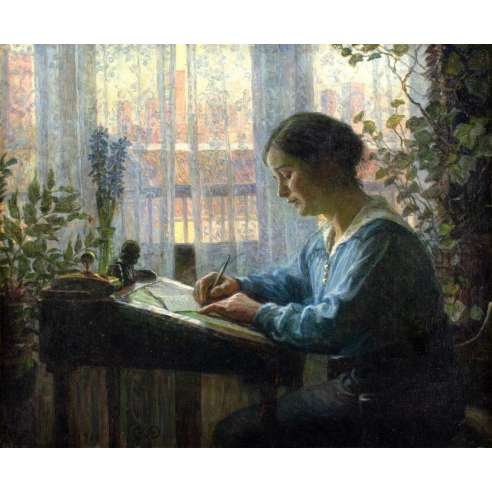"Else's Letter," painted in 1918 by Danish artist Caroline van Deurs, captures an intimate moment of a woman, presumably named Else, engrossed in writing a letter. This early 20th-century oil painting showcases Van Deurs' ability to convey a deeply personal and tranquil scene, emblematic of her storytelling prowess.
Composition:
Subject Placement: The young woman, Else, is centrally positioned, drawing the viewer's attention immediately to her act of writing. She is depicted in profile, her focused expression and poised pen highlighting the importance of her task.
Elements: The composition includes a writing desk, adorned with an inkwell and papers, with plants and flowers thoughtfully placed around the window, creating a natural frame around Else.
Perspective: The close-up perspective invites the viewer into this private moment, enhancing the sense of intimacy and immediacy.
Theme:
Solitude and Contemplation: The scene exudes a sense of peaceful solitude and introspection. Else’s flushed cheeks and absorbed demeanour suggest she is deeply engaged in her thoughts, possibly penning a letter to a dear friend or a distant lover.
Domestic Tranquillity: The serene setting, likely during a quiet morning or late afternoon, reflects a calm domestic environment, accentuated by the soft light filtering through the window.
Use of Colors:
Palette: Van Deurs employs a soft and harmonious color palette, predominantly featuring cool tones such as pale blues and greens. These colors enhance the tranquil and contemplative mood of the painting.
Contrast:
The subtle contrast between the darker interior elements (such as the desk and Else's dress) and the lighter background (the window and the delicate lace curtains) adds depth and focus to the composition.
Use of Light:
Natural Light: The light streaming through the window illuminates the scene with a gentle glow, casting soft shadows and highlighting Else’s face and hands. This use of natural light creates a warm and inviting atmosphere.
Soft Lighting: The diffused light enhances the peaceful ambiance, with the interplay of light and shadow adding texture and dimension to the scene. The light subtly catches the plants and the delicate details of the lace curtains.
Highlights: The highlights on Else’s face and hands emphasize her focused expression and the act of writing, drawing the viewer’s eye to these key elements.
Additional Details:
Textural Elements: The lace curtains and the foliage are rendered with meticulous detail, adding texture and depth to the painting. These elements create a rich, layered composition that feels both realistic and enchanting.
Background: The city view beyond the window, though softly blurred, suggests a quiet, possibly early 20th-century urban setting, further contributing to the painting’s serene and contemplative mood.




















